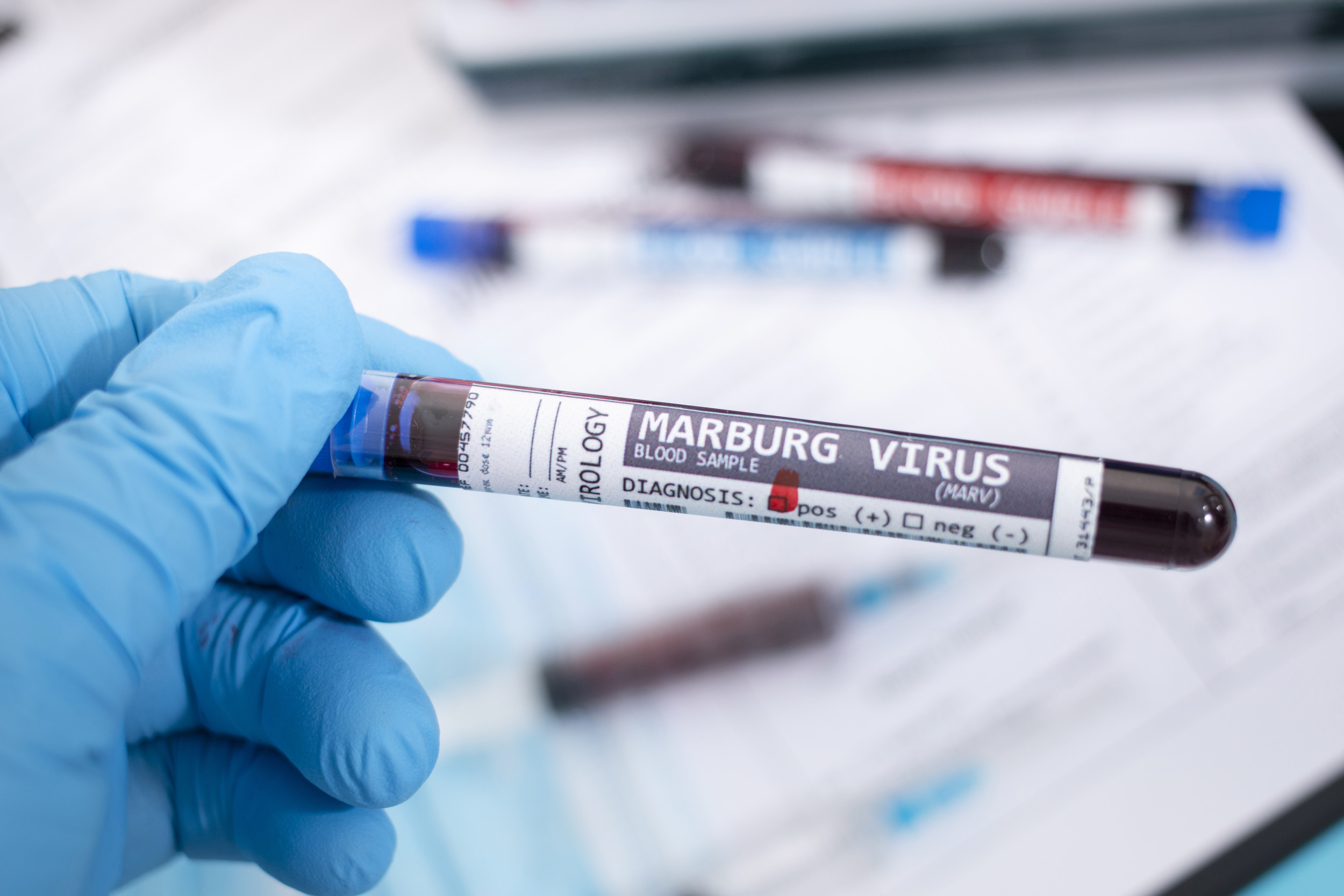
Deadly Marburg Virus Outbreak Hits Tanzania for First Time - Bloomberg - Source www.bloomberg.com
FAQ
This FAQ section provides vital information about the Marburg virus, a highly infectious and potentially fatal disease. Understanding this virus is crucial for preventing its spread and protecting public health.
Question 1: What is the Marburg virus?
The Marburg virus is a zoonotic RNA virus belonging to the Filoviridae family, which also includes the Ebola virus. It can cause a range of severe illnesses, including hemorrhagic fever.

Marburg virus outbreak in Uganda – what you need to know - Source theconversation.com
Question 2: How is the virus transmitted?
The Marburg virus primarily spreads through direct contact with bodily fluids, tissues, or secretions of infected individuals or nonhuman primates. Contact with contaminated objects can also transmit the virus.
Question 3: What are the symptoms of Marburg virus infection?
Symptoms typically appear within 5-10 days of exposure and include severe headache, muscle pain, fever, nausea, vomiting, diarrhea, and rash. In severe cases, patients may experience organ failure and internal bleeding.
Question 4: Is there a cure for Marburg virus infection?
Currently, there is no specific antiviral treatment for Marburg virus infection. Supportive care, including rehydration, electrolyte balance, and symptom management, is vital. Experimental treatments are under development.
Question 5: How can I prevent Marburg virus infection?
Preventive measures include avoiding contact with infected individuals, nonhuman primates, and potentially contaminated materials. Frequent handwashing, proper disinfection, and using personal protective equipment when necessary are essential.
Question 6: What is the prognosis for Marburg virus infection?
The fatality rate can vary significantly, but it has been reported to be as high as 88% in certain outbreaks. Early detection, supportive care, and appropriate infection control measures can improve the chances of survival.
Understanding these key questions and their answers empowers you with the knowledge necessary to protect yourself and others from the Marburg virus. Remember, staying informed and adhering to preventive measures is vital in minimizing the risk of infection and promoting public health.
Transition to the next article section: For more detailed information and updates, please consult reliable medical sources or visit the websites of the World Health Organization (WHO) or the Centers for Disease Control and Prevention (CDC).
Tips for Understanding the Deadly Marburg Virus
The Marburg virus is a severe and highly contagious disease that can cause a wide range of symptoms, including fever, headache, muscle pain, nausea, and vomiting. In severe cases, the virus can lead to organ failure and death.

Marburg Virus Outbreak: Tanzania Announces Spread of Deadly Disease - Source www.newsweek.com
Tip 1: Know the Symptoms
The Marburg virus can cause a wide range of symptoms, including fever, headache, muscle pain, nausea, and vomiting. In severe cases, the virus can lead to organ failure and death. It is important to be aware of these symptoms and to seek medical attention immediately if you experience any of them.
Tip 2: Avoid Contact with Infected Individuals
The Marburg virus is spread through contact with the body fluids of infected individuals. This can include contact with blood, urine, saliva, or feces. It is important to avoid contact with infected individuals and to wear protective gear, such as gloves and masks, when caring for them.
Tip 3: Wash Your Hands Frequently
Washing your hands frequently with soap and water is one of the best ways to prevent the spread of the Marburg virus. It is important to wash your hands after coming into contact with any body fluids, such as after using the bathroom or changing a diaper.
Tip 4: Avoid Eating Raw Meat
The Marburg virus can be transmitted through contact with the blood or body fluids of infected animals, such as monkeys and bats. It is important to avoid eating raw meat and to cook all meat thoroughly before eating it.
Tip 5: Get Vaccinated
There is no specific vaccine for the Marburg virus, but there are several experimental vaccines that are being developed. These vaccines have shown promise in preventing the virus in animal studies, and they are currently being evaluated in clinical trials.
For more information about the Marburg virus, please visit the Centers for Disease Control and Prevention website: Marburg Virus: Understanding The Deadly Infection.
Marburg Virus: Understanding The Deadly Infection
The Marburg virus, a highly pathogenic filovirus, poses significant threats due to its potential to cause severe illness and fatalities. Comprehending the essential aspects of this deadly infection is crucial for effective prevention and management strategies.
- Transmission: Marburg virus spreads through contact with infected bodily fluids or contaminated surfaces.
- Symptoms: Initial symptoms resemble those of other viral infections, but may progress to severe hemorrhagic fever.
- Diagnosis: Confirmation of Marburg virus infection requires laboratory tests to detect the virus or its antibodies.
- Treatment: No specific antiviral treatment exists; supportive care and symptom management are essential.
- Prevention: Infection control measures, including isolation of infected individuals and disinfection, are crucial.
- Outbreaks: Marburg virus outbreaks have occurred in several African countries, highlighting the need for early detection and response.
Understanding these key aspects of the Marburg virus provides a foundation for developing effective strategies to prevent and control this deadly infection. Timely diagnosis enables prompt isolation and treatment, while infection control measures help prevent further transmission. Additionally, research into the virus's biology and potential antiviral treatments is crucial for improving patient outcomes and minimizing the impact of future outbreaks.

Factfile: The Marburg virus, Ebola's deadly cousin - RFI - Source www.rfi.fr
Marburg Virus: Understanding The Deadly Infection
The Marburg virus is a highly contagious and often fatal filovirus. It is closely related to the Ebola virus and causes a similar illness, known as Marburg virus disease (MVD). MVD is characterized by fever, headache, muscle pain, and bleeding. It can also lead to organ failure and death.

Researchers move toward understanding deadly citrus disease - Source phys.org
The Marburg virus is transmitted through contact with infected blood or bodily fluids. It can also be transmitted through contact with contaminated objects, such as clothing or bedding. The virus is not airborne, so it is not spread through casual contact.
There is no specific treatment for MVD. Treatment is supportive and includes measures to manage symptoms and prevent dehydration. Ribavirin, an antiviral drug, has been shown to be effective in treating MVD, but it is not always available.
The Marburg virus is a serious public health threat. There have been several outbreaks of MVD in Africa, and the virus has also been detected in Europe and Asia. The World Health Organization (WHO) is working to develop a vaccine for MVD, but there is currently no vaccine available.
The Marburg virus is a reminder of the importance of infection control. Healthcare workers should always take precautions to avoid exposure to infected blood or bodily fluids. Travelers to areas where MVD is endemic should be aware of the risks and take steps to protect themselves from infection.
| Characteristic | Marburg Virus |
|---|---|
| Causative agent | Marburg virus |
| Transmission | Contact with infected blood or bodily fluids |
| Symptoms | Fever, headache, muscle pain, bleeding |
| Treatment | Supportive care, ribavirin |
| Prevention | Infection control, vaccination |
